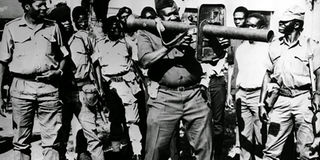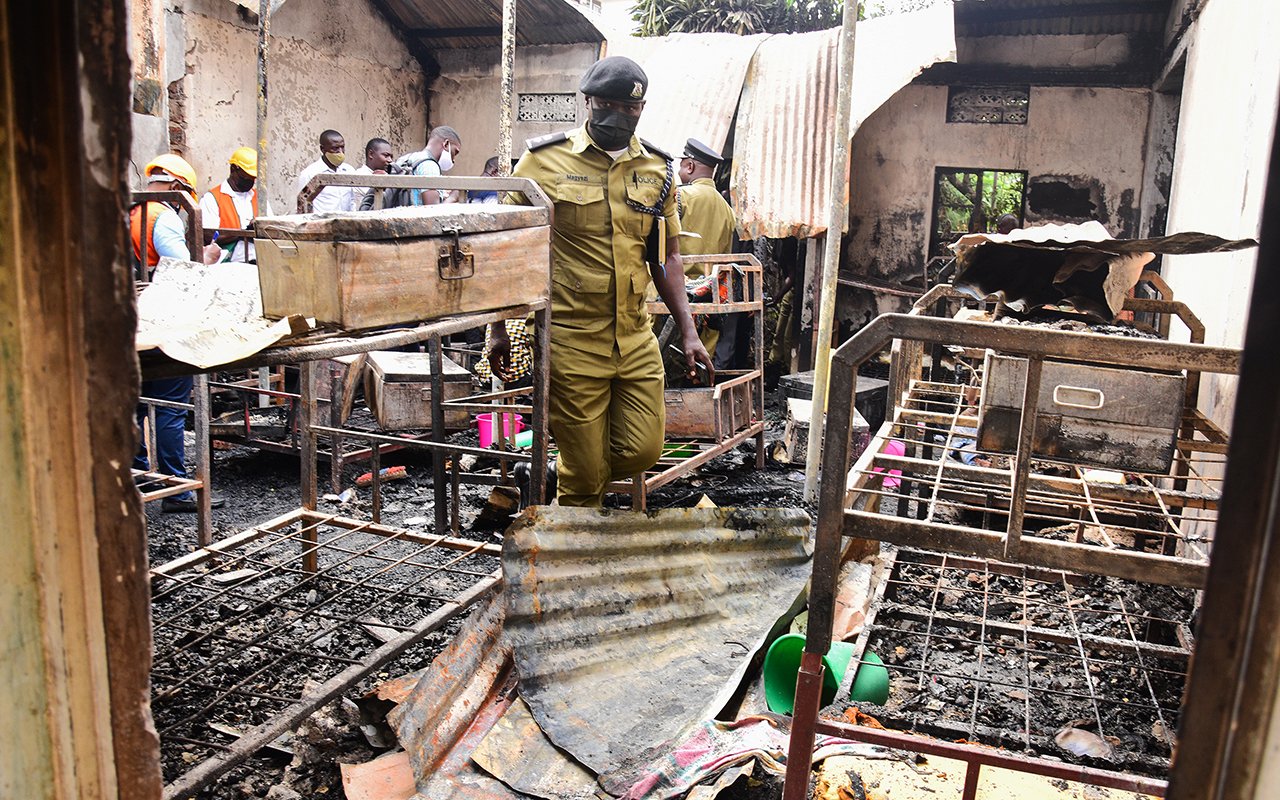Obote, Museveni blame each other for failed 1972 invasion of Uganda

Defeated invaders. Former president Idi Amin (centre) and his soldiers. FILE PHOTOS
What you need to know:
- History. Forty seven years have passed, but ghosts from the 1972 invasion still linger. It is believed that the botched September 1972 invasion was the one that opened the season for Idi Amin’s later killings.
Tuesday, September 17, will mark 47 years since contingents of about 1,300 Ugandan exiles in Tanzania entered Uganda from the south in an effort to attack and overthrow then president Idi Amin’s military government.
The attack was organised by former president Milton Obote in an attempt to regain power after having been overthrown by his army commander Amin a year earlier in the 1971 coup.
The initial plan for the invasion was a triple-pronged attack. One group of about 100 troops was to be airlifted from Kilimanjaro airport to Entebbe using an East African Airways DC-9 aircraft piloted by Capt James Lalobo.
They were to be commanded by Maj Gen David Oyite-Ojok to launch a surprise attack on the airport and after securing it advance onto Kampala. However, the tyre of the aircraft burst upon landing at Kilimanjaro and the plan was called off.
Meanwhile, the bigger group of about 1,300 infantry fighters, mainly comprising of Obote’s men who had been trained both in Sudan and Morogoro province of Tanzania, was split into two. The main one of about 1,000 members was directed to overrun Mutukula border point and then attack Masaka before advancing to Kampala. They were commanded by Gen Tito Okello Lutwa and Oyite-Ojok (after the aircraft tragedy).
Another smaller infantry group of about 330 fighters was commanded by Capt Oyile, Lt Okot (second in command) and Lt Okumu. The members of this group included a one Yoweri Museveni along with some 40 members of his Front for National Salvation (Fronasa) group. Among them were Kahunga Bagira, Mwesiga Black (T. Tumusime), Ruzinda, Raiti Omongin etc. They were to attack Mbarara through Kyaka and Nshungyezi and overrun the barracks before proceeding to Kampala.
At the initial stage of the invasion, both groups did progressively well against Amin’s soldiers. Okello-Oyite’s group surprised Amin’s soldiers at Mutukula and successfully overran their detachment, destroying a few armed jeeps, capturing a number of General Purpose Machine Guns (GPMGs) and a few tactical radios before hitting the road to Masaka, routing a number of Amin’s military units along the road.
However, as they reached Kalisizo, a few miles south of Masaka Town, they ran out of ammunition. As a result, they were fated for trouble. As they withdrew from Kalisizo, they fell into an ambush mounted by Amin’s army and many were either killed or captured. The survivors disintegrated and fled. About 169 fighters from this group were lost in the ambush.

Former Ugandan president Milton Obote (left) and his Tanzanian counterpart Julius Nyerere.
Oyile’s group did not fare any better either. They managed to overpower the army at Kaberebere trading centre, captured a few military jeeps and guns before overrunning several roadblocks en route to Mbarara Town.
However, as they reached Nyamityobora Forest, two of Amin’s jeeps armed with 106mm recoilless and a General Purpose Machine Gun opened fire which hit the invaders’ leading lorry, forcing most of them to disperse and flee in disarray. Most of them ended up hiding in the wananchi’s houses, who later handed them over to Amin’s soldiers for execution.
A few of them, including Museveni, retreated deep into the forest from where they found their way back to Tanzania.
In his book Sowing the Mustard Seed, Mr Museveni explains that at this point all the Obote’s leading commanders, including Capt Oyile, Lt Okot and Lt Okumu broke up and fled but were later pursued in their hiding places and handed over to Amin’s men.
In Oyile’s group alone, out of 330 fighters who had started off with nine lorries for Mbarara that morning, only 46 people and three lorries made it back to Tanzania. Thus 284 were massacred in that brief battle.
Later, when the fighters regrouped in Tanzania, out of about 1,300 men who left for the invasion, only 846 could be traced. Therefore, in a matter of only two days, 454 fighters had either been killed in the actual combatant or were captured and later executed.
Amin later paraded a huge pile of bodies before journalists, saying “...this is only a warning to [then president of Tanzania Julius] Nyerere.”
Blamed
Shortly after the failed invasion, former president Obote attacked his 28-year-old former research assistant in charge of records, Museveni, saying before the invasion Museveni had made him to believe that he had organised an army inside Uganda waiting to reinforce the invaders.
Obote also claimed that the invasion failed because, during the war, Museveni stole the ammunition truck and drove it way, thereby depriving the fighters of the most sensitive and essential material for the war against Amin’s soldiers.
However, President Museveni in his book Sowing the Mustard Seed refutes this claim. On Page 75 (first edition), he says it was Obote’s intrigue that led to the failure of the invasion.
“That was the time I decided never to work with Obote again,” writes Museveni who denied either giving any information to Obote prior to the invasion or even having any apparent knowledge of the invasion until September 14, 1972, (the invasion took place on September 17).
Obote’s account
During the autobiographical interview with Andrew Mwenda in 2004 from his exile home in Lusaka, Zambia, the former president unleashed a “fume of venom” at Museveni, blaming him for every detail of the disastrous invasion. He had this to say:
“Nyerere came to me in Dar-es-Salam and told me that a one Yoweri Museveni, who had been a student at Dar-es-Salam and had later worked in my office as a assistant research, had informed him that he had organised an army in Mbarara, Masaka, Jinja, Entebbe, Kampala and Mbale.
I asked him, ‘Can you give me time to check, Mr President?’
Then he said, ‘Take your time.’
I started working the telephone to people in Mbarara, Masaka, Jinja, Entebbe, Kampala and Mbale, but I regret to say I did not find any trace of recruitment and I reported this to Nyerere, advising him that we should not trust that story.
But Nyerere believed it because it was from his intelligence. He trusted his intelligence very much. Meanwhile, our invasion plan was on two fronts. One front comprising of about 100 troops was to be airlifted to Entebbe, to make a surprise attack on the airport, capture it and then advance to Kampala.
But tragedy befell this group when the tyre of East African Airway DC-9 aircraft burst upon landing at Kilimanjaro. The infantry group was to enter Uganda through Mutukula and attack Mbarara, Masaka and then advance to Kampala.
We had about 1,300 infantry who had been trained at Morogoro, reluctantly believing that Museveni had an army. Anyway we took them to Mutukula. Everything went on as planned except for the usual problems of delayed take off, bad roads and so on and so forth.
However, when our troops advanced onto Mbarara Town, there was no Museveni army. The same applied when the troops advanced onto Masaka Town. On Mbarara’s side, only one person, the husband of Frank Mwine’s sister, joined our troops. Museveni had lied! Whether Museveni had an army at all, we never saw any. Mbarara was a failure! Masaka was a failure! Our troops fought gallantly but against heavy odds and were beaten.
Many, including (former Information minister) Alex Ojera, Capt Oyile and Picho Ali were captured and later executed by Amin. Amin’s soldiers then went house-to-house, picked up our men and killed them.
Among those killed were (Mzee Nehemiah) Bananuka together with his three sons. Bananuka’s story is sad. Later, I was informed that this man, who joined our troops in Mbarara who was supposed to be part of Museveni’s imaginary army, was the one who led Amin’s soldiers from house to house, picked up our men and killed them.

Former Front for National Salvation (Fronasa) leader Yoweri Museveni.
My contempt for Museveni is based on my personal conviction as an individual, shaped by my up-bringing at home, and also on my institutional socialisation as a leader. I felt then and I still feel so now that Museveni is a very dangerous man. First, to deceive an African government and its president that he had an army and yet he did not have anything was a very bad and indecent act by him.
Two, to deceive us his colleagues who were prepared to fight the same cause with him that he had organised an army yet he did not have anything showed a callous mind that just wanted to kill people.
Later, I met Museveni casually after the invasion had been crushed. He was preparing to go to Moshi to be a teacher. I developed a very low opinion of him because I know him to be a lair.”
Museveni blames Obote
Museveni writes in his book that the 1972 invasion failed because of Obote’s intrigue that persuaded the Tanzanian government to allow the untimely invasion that ended into a total disaster.
Describing it as a huge mistake, he says it was difficult to understand why the Tanzanians took the risk of allowing such a dangerous scheme to be launched from their territory, especially when it was not even properly planned.
“My understanding was that Obote fed them with wrong information which gave them an impression that there was a large fifth column of his supporters within Ugandan population at large, as well as within the army,” Museveni writes.
He also adds that he only participated in the invasion because if he had failed to take part, he would have been accused of having leaked information to Amin.
Museveni also claims that he did not know any information about the invasion until September 14, 1972, when then Tanzanian minister of Defence Edward Sokoine came to see him in Bukoba and to tell him that the invasion would take place that evening.
“I asked him who was taking part and he told me that the main force comprised of about 1,300 of Obote’s people who had been training in Sudan and that we (Fronasa) were expected to go along too... I told Sokoine that this was absolute nonsense,” he notes.
Museveni says Obote’s claim that he (Museveni) had led him (Obote) into believing that there would be enough reinforcement coming to their aide if they invaded was a mere attempt to shift the blame, especially after the invasion proved a complete fiasco.
“If Obote believed I had identified an internal force, why did he not include me in the planning of the action? If he really wanted to utilise an ‘internal force’, he should have discussed his plan with me since I was the only person who had the contact,” Museveni writes in his book.
“How could he count on my contacts without informing me or them? The real explanation is that Obote, always a schemer, was trying to use some of the information we were giving him for his own purpose. He was only interested in using his opponent’s existing weakness to get back to power.”
Forty seven years have passed, but ghosts from the 1972 invasion still linger. It is believed that the botched September 1972 invasion opened the season for Amin’s later killings.
The invasion also undoubtedly cleared the ground for the future rivalry between Obote and Museveni that tantamount to the bloody Luweero war of 1981-86.




